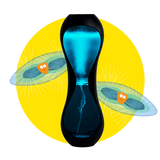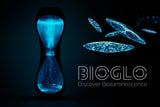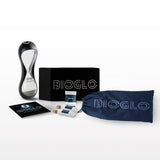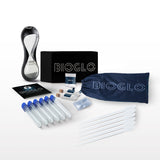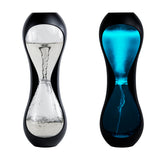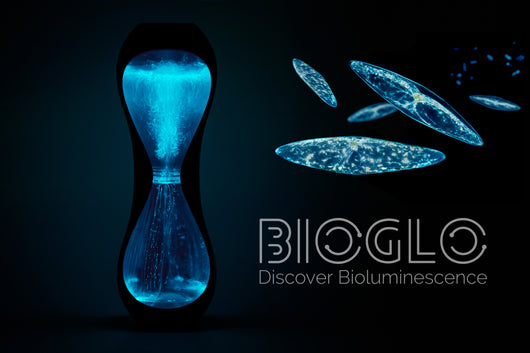
Enjoy BioGlo's three engagement modes:
- Bubble Mode: Letting the BioGlo bubble next to you as you go to bed will ease your mind and help you drift off to sleep.
- Streak Mode: Like little bolts of lightning, watch the dinos dazzle as they travel down the side of the hourglass body.
- Whirl Mode: Behold the power of hundreds of dinos lighting up together at once, forming a dazzling vortex display.
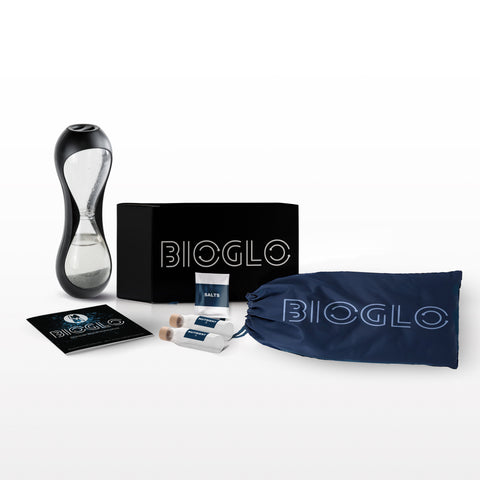
- 1 BioGlo Aquarium
- 1 Carrying Bag
- 1 Growth Medium (1 Salt Packet, 2 Nutrient Vials)
- 1 Dino Redemption Card
- 1 BioGlo Manual with 5 Experiment Suggestions
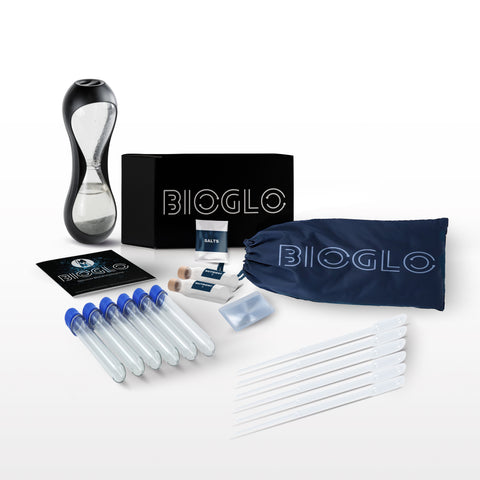
The BioGlo Explorer Kit includes:
- 1 BioGlo Aquarium
- 1 Carrying Bag
- 2 Growth Medium (2 Salt Packets, 4 Nutrient Vials)
- 1 Dino Redemption Card
- 6 Test Tubes
- 6 Pipettes
- 1 Magnifying Card
- 1 BioGlo Manual with 5 Experiment Suggestions

Why are my Dinos not in the box?
Your living Dinos need special treatment to survive shipping. So they must be shipped separately from the other BioGlo components. Simply follow the instructions on the Dino Redemption Card included in your BioGlo box, and your Dinos will be rush shipped to you.
I got my Dinos, but they aren't glowing. What's going on?
The Dinos are kept on a Light/Dark cycle where the light cycle occurs from 8 pm to 8 am (EST), and the dark cycle from 8 am to 8 pm (EST). This allows for the convenient study of the bioluminescent trait within a traditional classroom schedule. If you want to alter this schedule, it may take several weeks for the organisms to adjust and begin to show bioluminescence again
How long will my Dinos live?
A single Dino can live for 5-7 days. Assuming the Temperature and lighting conditions are good, your culture will theoretically continue to grow and divide indefinitely.
What and how often do my Dinos eat?
Your Dinos eat a special food called "Growth Medium." It's a tasty mix of sea salts, inorganic nutrients (like nitrates and phosphates), trace elements, and vitamins. You need to feed your Dinos every 3-4 weeks. One liter of Growth Medium should last about 6 months.
Can I alter my Dinos light/dark cycle?
Absolutely! You can use the BioGlo: BaseLight to alter the circadian rhythm of your Dinos by adjusting the time that the Dinos are exposed to light and dark. It can take several weeks for the culture to begin to glow again.
How do I dispose of my Dinos?
we do not advocate the release of organisms into the environment. In some states, it is illegal to release organisms, even indigenous species, without a permit. The intention of these laws is to protect native wildlife and the environment. Please call your local Game Warden or Wildlife Specialist for recommendations. We recommend the following:
- Donate your Dinos to another person
- Donate to a local zoo or wildlife center
- Dispose of humanely as a last resort
Need More Help?
We want you to have a good experience. If you have more questions please call 979.703.1925 or email info@magicalmicrobes.com
Quick Start Guide
- As soon as your dinoflagellate culture arrives, open the shipping container, remove the jar, and inspect for damage that may have occurred during the shipping process.
- Set up your BioGlo: BaseLight or fluorescent lamp with a cycle of 12 hours of light and 12 hours of dark. This is essential for recovering bioluminescence lost during shipping.
- Add your Dinos to your BioGlo with the Growth Medium
- Wait for your Dinos to recover from their jetlag, and adjust to their new schedule.
More Information about Dinos
- Our dinoflagellates are members of the genus Pyrocystis. Pyrocystis is derived from two Latin roots—pyro, meaning fire, and cystis, meaning hollow sac or cavity.
- Aristotle wrote of bioluminescent creatures in De Anima and other writings.
- The expression of bioluminescence in algae is thought to have evolved as a defense mechanism to avoid being eaten.
- Bodies of water where bioluminescent dinoflagellates bloom are popular tourist attractions in many parts of the world.
- Members of the genus Pyrocystis are non-motile and float at depths between 80 and 100 meters.
Preparation
As soon as your culture arrives, open the shipping container, remove the pouch, and inspect the culture for damage that may have occurred during the shipping process. Maintain at normal room temperature (65 to 75° F, 18 to 24° C). Avoid rapid temperature fluctuations.
Be aware that your culture may need a week or more to recover bioluminescent ability after it has been shipped. Simply moving the culture from light to dark is not sufficient for it to recover bioluminescence, as the chemical reaction is related to the organisms’ circadian rhythm. You will need to reestablish a circadian rhythm to recover bioluminescence before manipulating or diluting your culture. This process can take a week or more to complete, depending on the conditions your culture experienced during shipping.
Making the Dinos Glo!
To induce bioluminescence, gently shake the culture jar to agitate its contents. The individual dinoflagellates should give off brief flashes of bright, blue-green light. The dinoflagellates will not glow constantly, and the glow will fade as the culture is agitated multiple times within the same dark cycle. Allow the culture to recharge with a light cycle before attempting to observe bioluminescence again. If you have been unable to observe bioluminescence after 10 days of light cycles, please contact our technical support team.
This video shows binary division of Pyrocystis fusiformis. These cells reproduce by making zoospores inside the cell wall. The zoospores grow as a cyst until they can become their own cell group. This asexual miotic reproduction typically takes place nightly, and Pyrocystis fusiformis can double their population in 7-18 days.
Click here for a downloadable copy of the instruction manual




